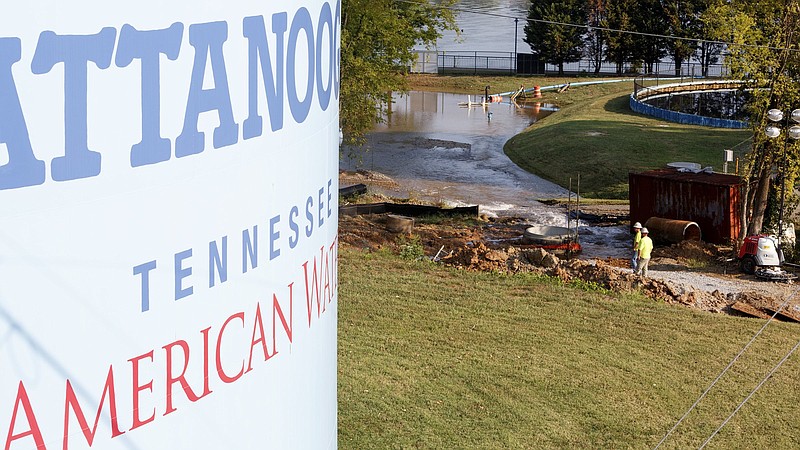"At American Water, we keep life flowing."
That is a sentence in one of the blurbs you likely found if you, like us, were searching the Tennessee American Water company's website for information about the long dry weekend in Chattanooga - a weekend when the water of life was not flowing from many Chattanooga water taps.
With temps in the high 90s under a brutal September sun, 35,000 households and businesses had no water.
Many large buildings - Memorial Hospital and the Tennessee Aquarium, for instance - had no air conditioning either, as water makes their "chillers" function.
Memorial Hospital had to purchase at least 50 portable fans. Animals died at the Tennessee Aquarium when cool-exhibit tanks overheated. Ten portable toilets had to delivered to the Hamilton County Jail.
Schools and businesses closed early Friday and many popular bars and eateries in our tourism-proud city remained closed over the weekend with a "boil water notice" hanging ominously over parts of the region.
Our water emergency began Thursday night when a 50-year-old, 36-inch water main broke near the Tennessee American water processing plant close to the water tanks beside the Tennessee River intake off Amnicola Highway. Water company officials said the break occurred about 20 feet from where crews were working on a planned maintenance project on another line - one of the city's largest water mains.
The days since have been an all-too-clear reminder of how vital clean water is to our lives and our economy.
Our disruption lasted only three or four days. Imagine the fallout in places devastated by natural disaster like the Bahamas and Puerto Rico? Imagine the impact on lives in other cities like Charleston, West Virginia, where a dangerous chemical spill into the Elk River literally forced the shut off of all water to some 300,000 people for two weeks in 2014. Imagine the disruptions still continuing in Flint, Michigan, where thousands of vulnerable children were poisoned with lead in the city's water supply because local and state officials were trying to save money on water treatments.
Here, we're still waiting for answers. For days now, neither Tennessee American Director of Operations Kevin Kruchinski nor Tennessee American Water Chief Engineer Kurt Stafford would confirm whether the break was related to the maintenance.
"Our current emphasis has been on isolation, repair and recovery. We know that a 36-inch pipe broke and released the water, and that is what caused the outage," Kruchinski said. "But what the root of it was, we'll work through that when the time comes."
That's unacceptable. We believe the people who handle our water supply should be able to walk and chew gum at the same time.
Here's another jewel of information from the Tennessee American Water website: American Water, a for-profit, publicly traded water and wastewater utility company, employs more than 7,100 professionals to serve 14 million people in 46 states (more than 100 workers for 360,000 people in Tennessee, according to a 2018 water system acquisition proposal submitted to the Signal Mountain town council).
If the 100-plus workers here can't fix a water main and tell the public what happened - while not creating confusion about whether a boil-water notice is mandatory or voluntary, and while providing a map that is actually readable - don't you think they could/should recruit some of that professional help from the other 7,000 workers in American Water?
This is no small thing. How much productivity and profit was lost in Chattanooga on Friday, Saturday, Sunday and early Monday? What about the delayed medical procedures? What of the lost lessons in our classrooms? What about the discomfort in homes where toilets wouldn't flush and families worried about having no water for drinking, bathing, cooking?
Yet when asked at each of the Tennessee American's half-dozen news conferences between Friday morning and Sunday evening, officials told reporters and the public that no information was available, or even being sought, until after full water quality is restored. And no city, county or Tennessee American Water official has yet been able to provide details on what the maintenance and emergency services cost, how much water was lost or how the fiscal impact of emergency response will be distributed. Officials have said that the broken water main is owned and operated by the water company, which has incurred all maintenance expenses related to the incident.
We certainly hope that our elected officials will be demanding a full lessons-learned post-mortem of this incident - complete with an accounting from Tennessee American of how many miles of 50-or-more-year-old pipe (pipe's average lifespan) is in our nearly 200 year-old city - along with the company's plan and schedule for replacing it.
We know there were some bright spots. Agencies - including the Chattanooga Police Department which distributed more than 300,000 bottles of water over the weekend - sprang into action. But we also know there's much to do to head-off the next water crisis.
According to the American Society of Civil Engineers' 2017 Infrastructure Report Card, which is published every four years, U.S. infrastructure gets a D+ grade. Drinking water infrastructure got a D.
Clearly, keeping life flowing here needs some critical attention.
